Strange deep sea creatures
The world we live in is a mysterious place with an abundance of
wonderful and weird things that can boggle our minds. Scientists have
succeeded in exploring and exposing some of these mysteries to us but
there is a lot more that is still untouched, especially in the
unreachable realms of the galaxy and the deep dark depths of the mighty
oceans. Today we like you to meet some strange creatures that dwell in
the depths of the oceans that would certainly fascinate you. Some may
call them weird while others may choose to see them as cute, especially
the not so monstrous looking creatures.
The Blobfish
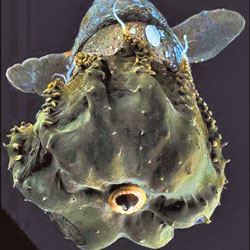 |
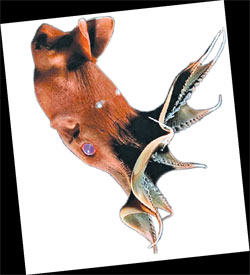
Vampire squid |
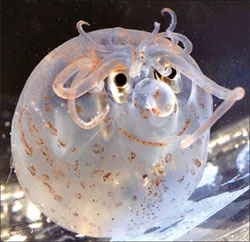
Piglet squid |
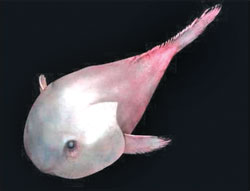
Blobfish |
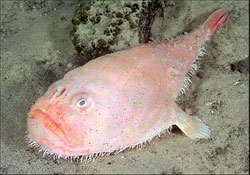
Coffin fish (above and below) |
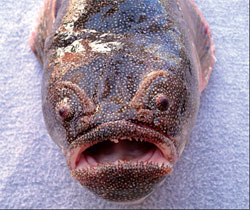 |
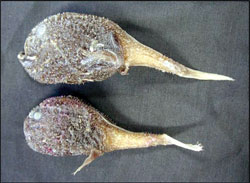
Coffin fish tadpole |
Have you ever seen a fish looking sad? Maybe not. However, if you
ever come across a species of fish named the blobfish (Psychrolutes
marcidus) you are bound to think that it is the saddest looking fish in
the sea. Perhaps, the fish looks very sad because it is under the threat
of extinction.Surprisingly it is on the verge of being wiped out not
because it is in great demand for any special feature or is of any
significant use to anyone as such, but because it is being dragged up
with tastier catches like lobster and crab. Blobfish are often
mistakenly caught by fishermen trawling for lobsters, which also often
live at great depths. A very large amount of the deep sea is under
threat from bottom trawling, which is one of the most destructive forms
of fishing.
The blobfish which can grow up to 12 inches in length is rarely seen
by humans because it is a deep sea fish of the family Psychrolutidae.The
bloated bottom dweller, lives at depths between 600-1,200 m (2,00-3,900
ft) where the pressure is several dozen times higher than at sea level,
which would likely make gas bladders inefficient for maintaining
buoyancy.
To remain buoyant, it evolved to have flesh slightly denser than
water, allowing it to float about without the use of muscles.The flesh
of the blobfish is primarily a gelatinous mass with a density slightly
less than water; this allows the fish to float above the sea floor
without expending energy on swimming. Its relative lack of muscle is not
a disadvantage as it primarily swallows edible matter that floats in
front of it. Blobfish eat invertebrates like crabs and sea pens. The
blobfish which is most noticeable for having the saddest face in the
ocean inhabits the deep waters off the coasts of mainland Australia and
Tasmania, but is rarely seen by humans.
Piglet squid
This funny looking piglet squid (Helicocranchia pfefferi), is about
the size of a small avocado and can be found most commonly in the
deepwater (greater than 100 m or 320 ft) of virtually all oceans. Its
habit of filling up with water and wild-looking 'tuft' of eight arms and
two tentacles had prompted scientists to name it the piglet squid.Some
consider this strange-looking creature cute. Do you think so?
Measuring just 3.9cm (10cm) in length the body is almost totally
clear revealing a dark mass that is the internal organs and barely
visible, feather-like gills. Pigment organs dot the surface of the
skin.There are two small fins at the opposite end of the body from the
head.
Very little known of its biology. It has been observed from
submersibles in the head down, but no one is sure why. It is a sluggish
swimmer with ammonium ions in its body fluid that help keep it bouyant.
A large light producing organ (photophore) is located beneath each of
its large eyes.
Its tentacles and skin patterns have formed an adorable shape of a
small smiling face with what looks like curly locks on his head. Because
of its deep water habitat, little is known of its behaviour.
Vampire squid
It is not more than six inches in length but the vampire squid, known
to scientists as Vampyroteuthis infernalis, looks like a creature from a
science fiction movie.
With large fins at the top of its body that resemble ears, globular
eyeballs about the size of those of a large dog which can appear red or
blue in colour, depending on the light, and a body covered with
light-producing organs called photophores which gives the squid the
unique ability to "turn itself on or off" at will ,through a chemical
process known as bioluminescence. It is no wonder that the squid is
given the monstrous name - vampire.
It is an ancient species and is a phylogenic relict, meaning that is
is the only surviving member of the order Vampyromorphida. It is a
unique member of the cephalopod family in that it shares similarities
with both squid and octopuses. In fact, it was originally and mistakenly
identified as an octopus by researchers in 1903.
Would you beileve that the squid has the ability to completely become
invisible in the dark waters where it lives when the photophores are
off? The squid has incredible control over these light organs. It has
the ability to modulate the size and intensity of the photophores to
create complex patterns that can be used to disorient predators and
attract prey.
The photophores are larger and more complex at the tips of the arms
and the base of its two fins. Unlike most other squid, it does not have
the ability to change its colour. This ability would be useless in the
dark environments in which it lives. The squid's light show is probably
its main form of defense, since it lacks the ink sack which is present
in other squid species. It can, however, eject a thick cloud of glowing,
bioluminescent mucus from the tips of its arms when threatened.
The fins are its primary means of propulsion and it literally flies
through the water by flapping them. As with other squid, it can also use
jet propulsion to move by expelling water through a specialised siphon
jet located just under its mantle.
The vampire squid has a very gelatinous form, resembling a jellyfish
more than the common squid. It can swim surprisingly fast for a
gelatinous animal, reaching speeds of over two body lengths per second.
Though it is relatively smal it has the largest eyes relative to its
body size of any animal. The vampire squid's eight arms are connected
with a webbing of skin, which makes it look more like an octopus than a
squid. When threatened, the squid can draw its arms up over itself and
form a defensive web that covers its body. Each of the eight arms is
lined with a single row of suction cups and rows of soft, fleshy spines
known as cirri. It is these spines, along with the cape-like webbing and
red eyes that give the vampire squid its unusual name. Located inside
the vampire squid's webbed arms can be found a pair of retractable
sensory filamnets. These filaments are similar to the two long tentacles
found on other squid species. Also located within the webbing are two
powerful beak-like jaws. These jaws are as white as ivory and are strong
enough to crush the shells of crustaceans. The squid's colour ranges
from jet black to pale red.
Not much is known about the feeding habits of the vampire squid. Its
diet is believed to consist of prawns, copepods, cnidarians, and other
small invertebrates. The beaks of vampire squid have been found in the
stomachs of seals, whales, and fishes, indicating that it is a favorite
prey item for many deep-diving species. The squid has an extremely low
metabolic rate, indicating that it can go for long periods of time
without feeding. This is an important adaptation seen in many deep sea
species since food can be hard to find at these extreme depths.
As with most deep water creatures, very little is known about the
reproductive habits of the vampire squid. We do know that the eggs of
the squid are small and opaque, reaching a size of about eight
millimeters. They are thought to reproduce slowly by laying a relatively
small number of eggs. The distribution of eggs has been found to be
similar throughout the year, indicating that there may be no particular
breeding season. Once the eggs hatch, the young hatchlings will drift
with the water.
They resemble miniature versions of the adults except that they lack
the webbing between the arms and their eyes are much smaller. As they
develop, the young vampire squid undergo what has been described as a
double metamorphosis. At early stages of development, the young squid
have a single pair of fins located near the eyes. At a later stage, this
pair of fins gradually disappears as a new pair develops. As the animal
reaches maturity, these fins are resized and repositioned to maximize
swimming efficiency.
Vampire squid are found throughout the deep oceans of the world in
most tropical and temperate regions at depths of between 300 feet (about
90 meters) and 3,000 feet (over 900 metres). They live in the oxygen
minimum layer of the ocean where virtually no light penetrates. They
seem to prefer a temperature between 35 and 43 degrees Fahrenheit
(between 2 and 6 degrees Celsius).
Fangtooth
From the depths of the ocean emerges another monster like crature
which is also only six inches in in length like the blobfish. The
fangtooth, also known as Anoplogaster cornuta, is a menacing looking
creature with a short body and a large head. The fangtooth gets its name
from the long, sharp, fang-like teeth that line its enormous, over-sized
mouth. Its gruesome appearance has earned it the name, "ogrefish". The
adults sport a body colour that ranges from dark brown to black but the
juveniles look completely different;they are light gray in colour with
long spines on their heads.
The fangtooth is an extreme deep-water species that lives at depths
of about 16,000 feet. Do you know that the pressure at these depths is
extremely intense and the water temperature is near freezing? Hardly
anyfood is found at these depths so ,it is believed that the fangtooth
will gobble up to just about anything it can find. Most of its meals
probably fall from the upper depths of the ocean.
The fangtooth is found throughout the world in temperate and tropical
ocean regions including the waters off the coast of Australia.
Coffin fish
The coffin fish (B.melanostomus) is a bottom-dwelling fish that can
be found almost anywhere in the world. These curious looking fish walk
along the bottom of the sea floor using their leg-like fins to crawl
around. It has a flabby body and long tail that are both covered with
small spines. It has a black mouth lining and an illicium (glossary) on
the snout that can be lowered into a groove.
This species grows to at least 10cm in length. B.melanostomus has
been trawled in the Central to Eastern Indian Ocean at depths ranging
from 1320m to 1760m. The name melanostomus comes from the Greek melanos
meaning black and stoma meaning mouth.
There are two genera in the family Chaunacidae; Bathychaunax and
Chaunax. Bathychaunax differs from Chaunax by having a lower lateral
line count, longer ilicium, a wider head, more widely spaced body spines
and several skeletal characters.
Facts and pix: Internet |

